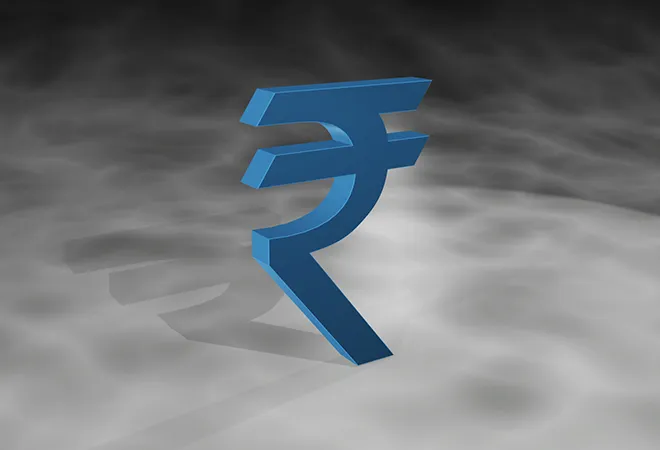
There is a myth that a falling currency helps exports grow. Some economists, including those associated with government-run institutions, have been opining that the Rupee should be allowed to fall, as it will lead to buoyant exports and economic recovery. There is also a mistaken notion that countries undervalue currency willfully so that the exports become more price competitive. No country other than China can manipulate its currency value and keep it low to boost exports. If that was so, the economies of Greece and Argentina would have miraculously recovered. Also, the US exports should have fallen and become really uncompetitive. But, though the US dollar perpetually grows in strength, so does US exports. While it is true that exporter profits improve when a currency value falls, there is no evidence to suggest that the exporter’s business volume increases as a result of currency devaluation.
Exports have been falling and so was the Rupee
India’s exports have been falling since the year 2011-12. The Indian Rupee has also been depreciating since March 2012. The US dollar which was valued at Rs 50.95 during end March 2012 had fallen to Rs 65 by March 2018 and further slumped to Rs 72.5 by end September 2018. But if you thought that exports rose proportionately, you would be mistaken. The last time that happened was six years ago when the Rupee fell by 14.2% and exports recorded a 21.8% growth. That was 2011-12 when exports touched $306 billion. That has been coincidentally the highest export growth in this decade after which exports have gradually slipped. It has not really recovered since then and was lower at $302.8 billion even in the year 2017-18, a relatively good year for exports.
If we see statistically, the export growth was negative at (-) 1.8% in the year 2012-13 and (-) 4.7% in the year 2013-14 when the Rupee tumbled. By end March 2013, the Rupee had slid by 6.6% to Rs 54.35 and by March 2014, it went down further. After a precipitous slump to Rs 68.00 in August 2018, it recovered to Rs 59.96 by March 2014. The net drop in Rupee value in the financial year ended March 2014 was a high 10.32% but that did not help exports grow.
The Modi Government was voted into power in 2014, but it was not able to do much to reverse the trend . The exports dropped by 1.3% in the year ended 2015 and a humongous 15.5% next year. Certain measures taken thereafter has improved the condition with exports rising moderately by 5.2% in the year 2016-17 and 9.8% in the year ended March 2018. The Rupee also continued its journey south as the Government was unable to check the rise of the current account deficit (CAD). By March 2015, the Rupee had declined by 4.08% to Rs 62.41 and by March 2016 it had fallen by another 6.1% to Rs 66.15. The currency recovered slightly by 1.9% to Rs 64.86 in the year ended March 2017 when exports actually rose. It slipped marginally by 0.4% to Rs 65.13 the next year. Both these years, exports were higher than previous years dispelling the notion that a falling currency helps exports.
Free fall of Rupee needs to be stopped
There are seven reasons other than the global headwinds that has led to the Rupee fall. Apart from the first, most of the others can be fixed. The first is the rise of global crude prices, which is not in our hands. The second is the rise of non essential imports (other than oil and gas) that has led to the increase in current account deficit. The third is the rising expenditure that has led to the budgetary deficit touching its annual limit in the first six months of the financial year. The fourth is the slow disinvestment programme for the current year that is well behind its schedule. The fifth is the half hearted recapitalisation of banks that again is creating uncertainty in the money markets. The sixth is lack of private investment because of uncertainty in the capital and bond markets again largely as the banking sector is reworking its options. The seventh is the lack of appetite shown by the RBI to defend the Rupee.
|
Export Growth versus Rupee Fall
|
| |
Export Growth |
Rupee Vs US Dollar |
| 2011-12 |
21.8% |
-14.2% |
| 2012-13 |
-1.8% |
-6.6% |
| 2013-14 |
-4.7% |
-10.32% |
| 2014-15 |
-1.3% |
-4.08% |
| 2015-16 |
-15.5% |
-6.1% |
| 2016-17 |
5.2% |
1.9% |
| 2017-18 |
9.8% |
-0.4% |
The free fall of the Rupee needs stopping. This is simply because India imports more than it exports. It is still not a difficult task because the demand side numbers are still good and the India growth story is still big. So investors and NRIs are still interested. It is the best bet amongst the BRICS. China is showing multiple weaknesses for the first time in two decades, with rising debt, sanctions, trade war, waning export markets and shrinking domestic demand. Russia is showing signs of weak growth, and economic isolation due to sanctions despite willingness to open its economy. Brazil is showing high inflation, rising debt, shrinking domestic demand, corruption and political instability. It’s election whose result will be announced on the last Sunday of October could bring in right wing strongman congressman Jair Bolsonaro. The leftist who have brought the economy to a crisis point fear that with Bolsonaro as President, many of them could land behind bars on corruption and other charges. South Africa has dived into recession following reckless nationalisation by the current Government, high national debt and lack of domestic demand. Comparatively, the Indian economy is a good bet.
Firm steps needed to revitalise exports
The Indian economy has been managed well in comparison to the other emerging economies. Both GDP growth and domestic demand is high and the fiscal deficit is under control. Though oil prices are a concern, the current account deficit is still not spiraling out of control like in 2013 when it touched 4.5% of the GDP. The resolution of stressed assets has already started and the stressed assets are being sold under the newly formed bankruptcy law. NPA due to bad debts have been rising fast, but with little more effort by the NCLT, the closures can be faster, like in the Western democracies. It is expected that the high NPAs in the Banks today will be firmly under control by March 2020 and with a few more mergers and acquisitions in the banking sector, public sector Banks should be more healthy than now in a years time.
What is needed, however, is speed of economic decision making in certain areas. Non essential imports must be identified and tariffs raised. Gold and olive oil imports need to be taxed heavily and taxes on diesel rationalised further. Import duties in the capital goods sector needs to be selectively raised so that industries like Telecom, Automobile and Consumer Durables where Indian consumers are the buyers are rapidly indigenised. The Trump Administration has shown that there is a scope for rapid indigenisation if any Government forces the issue.
Similarly tax incentives should be given for global acquisitions by exporters. China has shown that there is scope of greater exports if a nation encourages third party acquisitions on foreign soil only for exports. China has turned it into a fine art. Today if you import telecom or solar power equipment you will have fully owned Chinese companies based out of China, competing with partly owned Chinese companies based in Malaysia and Singapore as suppliers. Vishal Sikka of Infosys had proposed the transformation of the Indian IT giant into a global company with a similar plan. He had even acquired companies in Israel and South America for that purpose, so that exports to the US from those countries would not be deemed as exports from India by the Trump Administration. However, the inward looking management that took over Infosys following Sikka’s ouster has turned down his proposal of $1 billion strategic acquisition to transform Infosys into a global conglomerate.
Not only the Government but even the private sector must apply new methods to push exports, so that the earnings stay buoyant and the CAD stays low. This is crunch time for world trade with an ominous trade war creating deep fissures, that could lead to a global economic meltdown. The opportunities to expand exports at this stage must not be missed.
The views expressed above belong to the author(s). ORF research and analyses now available on Telegram! Click here to access our curated content — blogs, longforms and interviews.




 PREV
PREV


